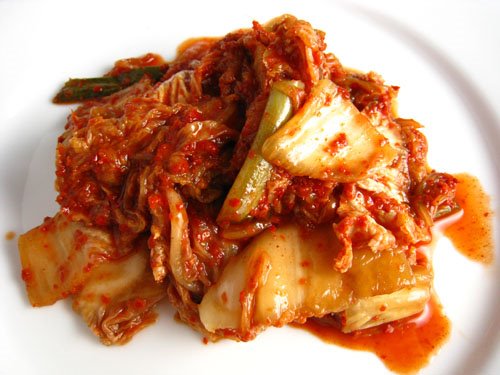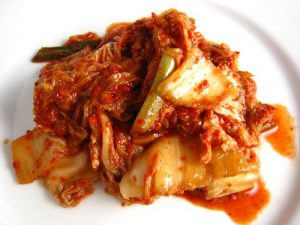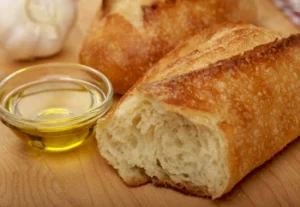
Have been making Kombucha for years now, and I love to eat other fermented foods, but I have not really done much experimenting with fermenting anything other than Kombucha over the years. Like, none. Believe it or not, I’m not much of a kitchen witch (outside of making dinner). But maybe I’ll get inspired

Fermented foods are known to be a traditional part of diets all over the world and throughout time. How long have people been making fermented foods? According to Mark’s Daily Apple, wine, bread and fermented milk have been around for at least 7,000 years. Mark continues:
“The Inuit traditionally wrap whole seabird carcasses in seal pelts and bury them underground to ferment for months; rotting fish is another feature of their traditional diet. Fermented dairy is a major aspect of the traditional Masai diet, as is clotted steer’s blood. The list goes on and on: East and Southeast Asia with natto (fermented soy), kimchi (fermented cabbage), soy sauce, fermented fish sauce, fermented shrimp paste, to name just a few; Central Asia with kumis (fermented mare milk), kefir, and shubat (fermented camel milk); India and the Middle East with fermented pickles, various yogurts, torshi (mixed vegetables); Europe with sauerkraut, kefir, crème fraiche, and rakfisk (salted, fermented trout); the Americas with kombucha, standard pickling, and chocolate; the Pacific region with poi (fermented, mashed taro root) and something called kanga pirau, or rotten corn.
What a list! The benefits of fermented foods are well known to many, especially those educated about Kombucha, but I’ll give a quick list of the most commonly accepted ones:
- Improve Digestion
- Restore Pro-Bioti Balance to Your Gut
- Full of Vitamins,
- Especially Bs
- Deliver Necessary Enzymes
- Help the Body to Break Down andAbsorb Nutrients
- Save Money
- Preserve Food for Later
Author Rebecca Wood states, “It is alive cultured foods, especially those high in lactic acid, that strengthen your immune system. They do so by helping you maintain a healthy population of micro-flora in your gut. A healthy adult gastrointestinal tract contains over two pounds of micro-flora.” Wow!
———————————
However, as usual, what you are looking for on the label at your local grocery store may not be inside the product you are buying. Many of the commercially sold foods we assume are being fermented may not be fermented at all. I’ll let the fantastic blog, Wild Fermentation, deliver the bad news:
“Similar compromises apply to most of the fermented foods that have survived the last century of food industrialization. Pickles and relish are no longer fermented at all, but preserved in vinegar and sterilized with heat in the canning process. Wine is treated with sodium metabisulfite before fermentation to destroy wild bacteria and yeasts that make the results less predictable. Beer is usually pasteurized or microfiltered to kill or remove living yeast. Yogurt survives, but it just isn’t as good after the first day; the same is true of bread. Sauerkraut is usually pasteurized. To be sure there are niche brands, available in health-food stores, which are still living foods, but then freezing or refrigeration is necessary. This is rather ironic, since a major motivation for fermenting foods in the first place was to preserve them, in the days before refrigeration.”
(By the way, the article linked above is one of the best articles I have read on the relationship between food and community. If you have the time, it is well worth it.)
Yeah, that qualifies as bad news at first, but then at least you are educated. You can go to the store and look for the real stuff, or even better, make it yourself at home.
———————————
So here’s a little breakdown of my 5 Favorite/Most Intriguing Fermented Foods. Some of these I want to make myself, and some I just love. Weigh in with your favorites in the comments:
5. Cheese / Chocolate
I’m cheating here and including both of these typical “treat” foods since they are indeed fermented and are celebrated in many cultures as health foods. Cocoa beans are fermented before they are roasted and even though I’m from Chicago, I am a self-professed Cheesehead! 😉 We all know just how good a stinky fermented cheese can taste! Any excuse to include more of these in my diet sounds good to me.
4. Sourdough Bread
I love bread of all kinds, though I have been eating more unleavened bread lately. Still, nothing compares to a freshly baked sourdough. The smell of the yeast and the moist inside entice me initially. Fill it with fresh seafood chowder, hand me a spoon and allow me to stare out into the misty SF Bay and I am at risk of passing out from overblissed-itis.

3. Sauerkraut / Kim-Chi
Sauerkraut is the German staple, Kim-Chi the Korean. I buy Bubbie’s Sauerkraut and use it as a side dish with meals because I have always assumed it is not pasteurized. But now the Mad Fermentationist has me paranoid. I looked at the jar and it doesn’t say “raw” or “pasteurized.” So then I read the ingredients: Cabbage, Water, Salt. No vinegar. I think that means it’s good Sauerkraut.
As for Kim-Chi, I lived in Taiwan and travelled a bit in mainland China, but I never made it towards Korea. Though I have had a bite here and there, I have been a bit overwhelmed by the spice and smell. Still, I was very intrigued when I read this home recipe which calls for adding salt only AFTER the fermentation is over to maximize the positive bio-flora.
Being of German descent, I guess I’m a (sweet) Kraut who loves the (sauer) Kraut.
2. Yogurt
This is one I am definitely going to try making at home very soon. My friend Mark at Organic Pastures told me I can make an awesome raw yogurt smoothie. All I have to do is wait for his raw milk to get a little old (about 10 days), then leave covered on the counter to ferment for 24-36 hours. Toss in the blender with fruit and ice and that’s a powerful drink. Nothing at all like the sugary stuff from the store, fresh yogurt is sour and alive.
Poking around online turned up this recipe for a more traditional raw yogurt (warning: pdf), though it does require a yogurt maker. I’ve heard a heating pad and metal pot can work instead.
(I’ll pass for now on following the recipes that call for heating to 185 degrees.)
1. Pickles (pickled cucumbers that is)
I am a longtime pickle addict. Pickle spears. Pickle chips. Pickle halves. Pickle JUICE. (my mouth is watering just thinking about pickles!) Whatever, it’s all good, unless it has that chemically taste many of the major brands exhibit. I love finding all natural brands or even better a jar of oversized homemade ones at the deli. Puckery goodness. I think the only reason I’ve never tried making them before is I must be scared. I’ve read it is very easy though. I might even have an appropriate sized jar laying around somewhere. 😉
UPDATE: How could I have forgotten to check out my friends HellaD for info?! Check out this amazing Lacto-Fermented Pickle recipe, plus this article on lacto-fermentation. Dang I have a lot to learn.
———————————
What’s your favorite fermented food? And how pure are you about calling things fermented? Let me know in the comments.
Next week, Part II: Fermented Drinks.
I wonder what will be #1? Hmmm. 🙂
Jeannie
June 13, 2020 at 11:05 amWhen yogurt making no yogurt maker needed. Use your instapot! It will hold 100 degree temp! Plus unlike yogurt maker is only a yogurt maker..instapots are a daily use wonderful appliance
Rich L
September 8, 2019 at 2:08 amFavorite ferment. Home made Sourkraut that’s has been fermenting at least 6 to 12 months. Cab age.salt, with other spices for flavor. Turmeric and pepper is really good.
Fermented carrots is great for snacks.
I’ll ferment potatoes before making French fries, or potato soup. Also good with fermented broccoli added.
Chopped Garlic fermented in honey is a good base for may recipe Ed like a veggie or fish glaze or simple adds little oil for a salad dressing.
Allen Marks via Facebook
September 26, 2011 at 2:22 pmthanks Hannah, I am waving that k flag wherever possible.The scoby you sent me is still makin babies and I am passing your name on…
hannah
October 11, 2011 at 7:43 amWoot! Woot! Its a KT parade =)
Melissa
October 20, 2010 at 8:35 pmSauerkraut is soooo easy to make. I recently made some with cabbage, whey and salt. It's been in my fridge for a couple months and tastes heavenly! If you have a little extra time, it's worth making from scratch. Thanks for the great post!
Bryan Davis
October 20, 2010 at 4:51 amThanks for the compliment Hannah.
Bryan Davis
October 20, 2010 at 1:07 amInvisiGyrl – Try this-
Reserve a bit of the kimchi liquid (and or whey), add to a new brine and fresh veg, then wait a few days. You really shouldn't add fresh veg to the finished product.
Similar to the kombucha process, it takes time and a specific biological progression.
Not trying to be a sour puss, but it's important.
Feel free to contact me directly.
I bug Hanna all the time with kombucha questions. Least I could do is help out one of her friends.
Gloria
October 20, 2010 at 1:01 amWhen I was pregnant I would crave sauerkraut and brie, but not together of course. Yummm
InvisiGyrl
October 19, 2010 at 7:43 pmI bought some home-made Kim Chi at the local Oriental Market. It is delicious, but I think her recipe needs a little tweaking for my taste, so I buy a big half-gallon jar ($12) and bring it home, add a bunch of new veg and let it go for a few days. Since it's already jump-started, only takes a couple days to perfection!
I also made my first sauerkraut (still going) and my Kombucha is wonderful lately. I have trouble with raw veg, fermenting and culturing is the way to go!
YuMMM
Rich L
September 8, 2019 at 2:22 amI’m not sure why you would have problems with raw vegitables ferments. Maybe not enough or too much salt. Temperature too cold or hot.
2.5 salt salty ion is recommended but I prefer 2 and haven’t had any issues except in 85°F or higher. I even brew it at 55°F but it does slow down and this adds to the complexity of taste.
bitt
October 19, 2010 at 6:49 pmI love some good kraut.
Hannah Crum
October 19, 2010 at 5:59 pmThanks Bryan! Great tips and good to know I've got an expert to turn to if I need help! 🙂
Bryan Davis
October 19, 2010 at 5:50 pmI'm a fermentation enthusiast.
My favorite fermented food is sauerkraut made only with cabbage and hungarian hot peppers. Plain and simple.
I'm also a fermentation snob, nothing counts but the real deal. Especially pickles and sauerkraut- They're always fake or inoculated.
To be honest, even an inoculated fermented food has advantages. For one, it's real food! So that's hard to beat.
BTW- You can also use kefir grains for a salt free kraut/kimchi.
No need to buy some secret powder potion and the kefir grains go on indefinitely like the kombucha culture.
I'm actively recruiting some family and friends in So. Cal to look you up. Wish me luck. Keep up the great work. We need leaders, we need you.